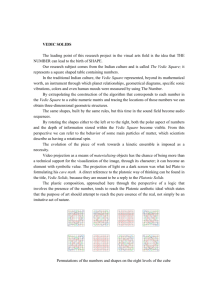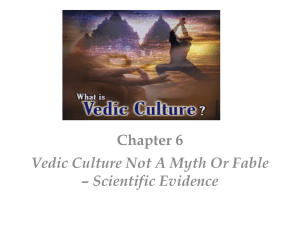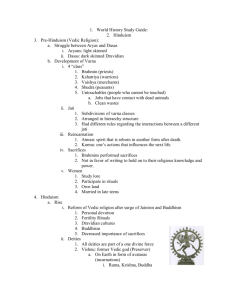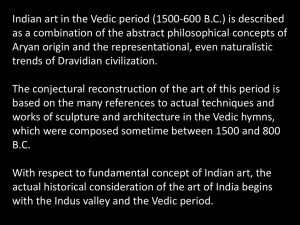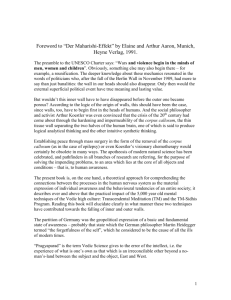the system of vedic mathematics - a comparison
advertisement
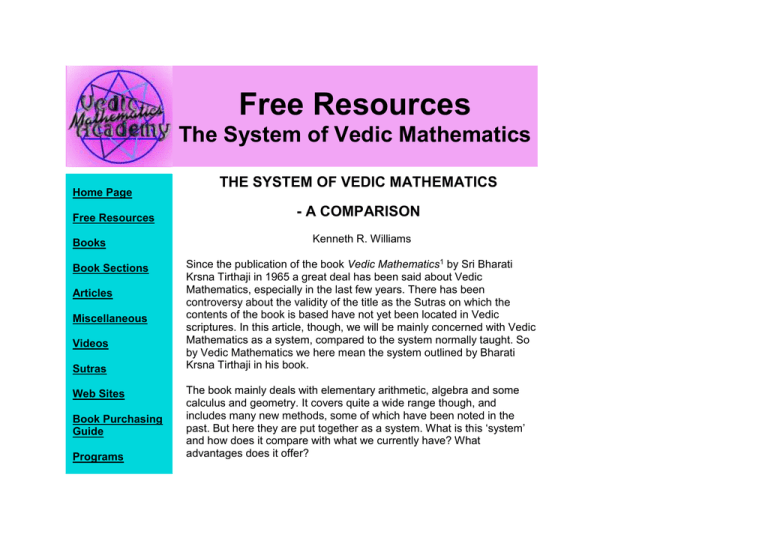
Free Resources The System of Vedic Mathematics Home Page Free Resources Books Book Sections Articles Miscellaneous Videos Sutras Web Sites Book Purchasing Guide Programs THE SYSTEM OF VEDIC MATHEMATICS - A COMPARISON Kenneth R. Williams Since the publication of the book Vedic Mathematics1 by Sri Bharati Krsna Tirthaji in 1965 a great deal has been said about Vedic Mathematics, especially in the last few years. There has been controversy about the validity of the title as the Sutras on which the contents of the book is based have not yet been located in Vedic scriptures. In this article, though, we will be mainly concerned with Vedic Mathematics as a system, compared to the system normally taught. So by Vedic Mathematics we here mean the system outlined by Bharati Krsna Tirthaji in his book. The book mainly deals with elementary arithmetic, algebra and some calculus and geometry. It covers quite a wide range though, and includes many new methods, some of which have been noted in the past. But here they are put together as a system. What is this ‘system’ and how does it compare with what we currently have? What advantages does it offer? The first thing to note is that the book is an introduction; it is not supposed to be a full exposition of Vedic Mathematics and was written in the author’s final years. I was given a copy of the book in 1971 and was amazed at its style and content. Some of the claims made seemed preposterous, but, given the integrity of the author and the originality of the material in the book, it seemed reasonable to study the work carefully first to see if there could be anything in it. Various extensions of the techniques became obvious and also applications in other areas of mathematics; and a clear and beautiful system gradually emerged. Let us begin by comparing the Vedic and traditional methods for obtaining the product of two 2-figure numbers. MULTIPLICATION Using the Sutra Vertically and Crosswise we can multiply any two numbers together in one line using this general Vedic method. Suppose we want to multiply 45 by 63: 45 63 2835 4 1 a) We write the numbers out as shown and begin by multiplying vertically: 5×3=15, so we put down 5 and carry the 1 as shown. b) Then we multiply crosswise and add the two results: 4×3 + 5×6 = 42. To this we add the carried 1, so we put down 3 and carry 4 to the left. c) Finally we multiply vertically on the left: 4×6 = 24 and adding the carried 4 we get 28 which we put down. The simple pattern used makes the method easy to remember and it is very satisfying to get the answer in one line. It is also easy to see why it works: the three steps find the number of units, the number of tens and the number of hundreds in the answer. Let us compare this with the usual method of ‘long multiplication’. 2 2 8 4 5 6 3 1 3 5 7 0 0 3 5 Here we have two lines of working before we get the answer, we have to remember to put the zero down on the right on the second line and there is no memorable pattern as there is with the Vedic method. LEFT TO RIGHT The Vedic method though, has many other advantages. For example it can also be carried out from left to right. Let us find 45 × 63 from the left: 4 5 2 8 4 6 3 3 5 2 a) Vertically on the left, 4×6 = 24, write down 2 and carry 4 to the right. b) Crosswise we get 4×3 + 5×6 = 42 (as before), add the carried 4, as 40, to get 82, write down 8 and carry the 2. c) Finally, vertically on the right 5×3 = 15, add the carried 2, as 20, to get 35 which we write down. We always add a zero to the carried figure as shown because the first product here, for example, is really 40×60 = 2400 and the 400 is 40 tens. So when we are gathering up the tens we add on 40 more. This does not seem so strange when you realise that a similar thing occurs when calculating from right to left: in the first calculation above the first vertical product (on the right) was 15, and although the 1 in 15 stands for 10 it was counted as one unit in the next column. These Vedic techniques can be extended to products of numbers of any size. The second method, from left to right, is useful for mental calculation because we write and pronounce numbers from left to right and so it is easier to get our answers the same way. Another advantage of calculating from left to right is that we may only want the first one, two or three figures of an answer, but working from the right we must do the whole sum and get the most significant figure last. In the Vedic system all arithmetic operations can be carried out from left to right and this means we can combine operations: obtain two products and sum them for example, or obtain two squares, sum them and take the square root. So we get answers digit by digit from left to right. We can extend this further to the calculation of sines, cosines, tangents and their inverses and the solution of polynomial and transcendental equations (which cannot be calculated from the right as there is no last figure).2 The same vertical and crosswise method can be used for algebraic multiplications. For example (2x + 5)(3x + 1): 2x + 5 3x + 1 6x2 + 17x + 5 Either direction will do. From the left we have: vertically: 2x × 3x = 6x2, crosswise: 2x × 1 + 5 × 3x = 17x, and vertically: 5 × 1 = 5. The conventional system does not use the same method for multiplying algebraic expressions as it uses for arithmetic products. It does something completely different: as shown below by the curved lines, we multiply the first by the first, the last by the last, the inner pair and the outer pair. This works nicely but is not related to the way the conventional system multiplies numbers. In the Vedic system however we find that once we know how to multiply, divide, take a square root etc. of numbers, we can use the same technique with polynomial expressions. This close link between algebra and arithmetic in the Vedic system means the practice of arithmetic builds up skills in algebra too. This shows that the Vedic system is simpler and more unified than the modern methods, which seem to be a hotchpotch of techniques that have come to be the standard ones over the years, but have little real coherence. This simplicity also suggests that this method could have been known in the past (it is in fact given by Leonardo of Pisa in his book "Liber Abaci") and could well have been used by the enlightened mathematicians of Vedic times. If a place-value system was then used to represent numbers the multiplication and division techniques given by Bharati Krsna Tirthaji could very well be the same as those used in the Vedic civilisation. DIVISION Unlike the conventional multiplication technique the Vedic method can be simply reversed to give us a one line division method. Suppose we want to divide 2835 by 63. This means we want to find a number which, when multiplied by 63 gives 2835, or in other words we want a and b in the multiplication sum below: a b 6 3 2 8 3 5 a) Since we know that the vertical product on the left must account for the 28 on the left of 2835, or most of it, we see that a must be 4. This accounts for 2400 of the 2800 and so there is a remainder of 400. A subscript 4 is therefore placed as shown. b) Next we look at the crosswise step: this must account for the 43 (43), or most of it. One of the products gives: 4×3 = 12 and this can be taken from the 43 to leave 31 for the other product, b×6. Clearly b is 5. The cross-product is therefore 42 and so there is a remainder of 1, which we carry to the right. Now the right vertical product is 5×3=15, and as this is exactly what we have left there is no remainder and the answer is exactly 45. In fact Bharati Krsna Tirthaji gives a different arrangement for the general division method which further simplifies the work. This can be presented to children in the form of a game or puzzle once 2-figure multiplication is established. By contrast the conventional long division method, shown below, is cumbersome and slow and is not obviously related to long multiplication. We practically need the multiplication table for 63, whereas with the Vedic method we just divide by 6, the first figure of the divisor. Even with long divisors we need only divide by the first digit in the Vedic system. 45 63)2 8 3 5 252 315 315 000 This method is easily developed for division of any number by any other number to any number of significant figures, and even dividing polynomial expressions. Furthermore the multiplication method described here simplifies when the numbers being multiplied are the same, i.e. for squaring numbers. And this squaring method can also be easily reversed to provide one line square roots: easy to do, easy to understand. These illustrations show that not only does Vedic Mathematics have a system but it is more unified than the conventional system. The same coherence in the Vedic system can be demonstrated in other areas of mathematics. FRACTIONS For example, addition and subtraction of fractions, which is normally very difficult for the children to remember and understand can be done immediately with Vertically and Crosswise: using the simple pattern and putting the answer straight down. It is also easy to understand. This gives a unity to the four operations of addition, subtraction, multiplication and division of fractions. SPECIAL CASES The conventional system uses few special cases. For example if you needed 56×10 you would not use long multiplication, you would just put the zero on the 56. But the conventional system does not go nearly far enough: it tends to stick to one method rigidly. If we needed 88×98, for example, the conventional system uses the same long multiplication method, and it is not a particularly attractive sum with those big digits: eights and nine. But these numbers are close to 100 and you might expect there to be an easy way to get their product. In the Vedic system there is. You may be familiar with the Vedic method. -12 -2 88 × 98 = 86/24 It is not usually set out like this, but seeing the numbers are close to 100 we naturally think of the deficiencies (12 and 2) of the numbers from 100, which here are placed over the numbers (on the flag), the minus signs indicating that the given numbers are below 100. The left-hand part of the answer, 86, is found by taking one of the deficiencies from the other number: 88 – 2 = 86 or 98 – 12 = 86 (whichever you like), and the 24 is simply the product of the deficiencies: 12 × 2 = 24. It could hardly be easier. This technique is capable of an extraordinary range of variations and it can easily be explained: algebraically, arithmetically or geometrically. There are many special cases in the Vedic system, but you do not have to use them as the general method is always available. This adds to the fun of doing mathematics though: having only one method, which is always applied, for multiplication, division, solving equations etc. leads to rigid thinking and is boring for most people. The variety of methods in the Vedic system on the other hand gives the student a choice about how to solve a problem and so they start to be creative: they think more about what they are doing and start inventing their own methods. Just as in everyday life we are faced with many challenges and each has to be approached in its own way, similarly every mathematical problem invites its own unique method of solution. MENTAL MATHS Another aspect of the Vedic system is that as the methods are so easy and can also be carried out from left to right, calculations can be done mentally. This gives confidence, greater mental agility and improves memory; students become more flexible and innovative and this has an effect on their other studies. Years ago I tutored a fourteen year old boy who had broken his leg and could not get to school. He was in a large comprehensive school and for maths he was in the bottom class out of six. He noticed that I tended to do calculations mentally and began to do the same. When I noticed that I showed him how to multiply two 2-figures numbers in his head. He was delighted and could soon multiply the numbers quite quickly. Then I showed him how to multiply two 3-figure numbers. When it was explained I gave him two numbers to multiply. After a while he gave the answer and when I told him it was correct he was really amazed and delighted. It was a special moment for him: he had done something that probably no-one in his school could have done, including the teachers. It is sometimes argued that with the advent of the electronic calculator the Vedic methods are obsolete. The calculator has its uses but the teaching of mathematics is about a lot more than just getting an answer. And although the calculator can save us a lot of time we should still be able to manage without it if necessary. EQUATIONS In the solution of equations we see another example of the contrast between the Vedic and traditional systems. The children nowadays are taught to tackle equations by writing down every line of the solution in a rigid way. They are not challenged to find the answer mentally or to notice special cases. This must lead to inflexible and dull thinking. But children are naturally creative and spontaneous and in most cases are not challenged enough. To solve an equation like: 7x + 5 = 4x + 20 we insist that they take 5 from both sides: 7x = 4x + 15, then take 4x from both sides: 3x = 15 and then divide by 3: x = 5 But just looking at the equation we can see that there will be 3x on the left and 15 on the right so that x must be 5. The Vedic system encourages us to look at the equation and let the mind just go to the answer. The actual working (whether mental or written), and the logic, is the same in both cases: it is the attitude that is different. Similarly, given the equation: the student of Vedic Mathematics sees immediately that the equation is linear as crossmultiplication would give x2 on each side and would spot that x = 0 is therefore the only solution since . The traditionally taught student wastes a lot of time in getting x=0 and then realises (perhaps) that it was actually obvious, but he has never been taught to take a good look at the problem before starting to solve it. OTHER EXAMPLES Similarly trigonometric equations can be solved with much greater ease using Vedic methods. In coordinate geometry and in applied mathematics too the Vedic system gives a new unity and new and highly efficient methods. The book Triples3 shows that the standard formulae for rotations in a plane, finding the distance of a point from a line, finding the angle between two lines etc. can be replaced by a single vertical and crosswise operation for adding or subtracting Pythagorean triples. And complex numbers can be multiplied just as triples are added and can be divided as triples are subtracted. The square root of a complex number can be written straight down. One textbook shows the standard method of finding This has 17 lines of working: we call the required result a + bi, square both sides of the equation thus formed and equate real and imaginary parts to get a² – b² = 15 and 2ab = 8. Substituting from the second equation into the first leads to a quartic equation which is then factorised to give two quadratic equations. This gives the two values of a and the corresponding values of b can then be found, giving But using Vedic Mathematics we simply complete the triple: 15, 8, 17 and find 15+17=32, so that the first two elements of the half-angle triple are 32, 8 or 4, 1 (cancelling down). Since 42 + 12 = 17 (the third element of the triple) the modulus of the complex number has been ‘squarerooted’, and the argument has been halved, so again a one line answer. This is THE SUTRAS The Vedic system uses a collection of sixteen Sutras and some subSutras. These are short memorable phrases, sometimes just a single word. For example, Vertically and Crosswise, Proportionately and On the Flag. They are clearly considered by Bharati Krsna Tirthaji to be an important aspect of Vedic Mathematics. It is easy to see that a phrase like Vertically and Crosswise could be useful for pupils; to remind them of a specific technique or way of tackling a problem. But they raise many questions: why are there sixteen Sutras, where do they originate from, what are sub-Sutras? The question about the authenticity of the Sutras cannot be answered, at least from a western point of view, by finding some reference to them in the extant literature. Because they appear in a book or other text does not make them valid, it just means somebody once thought they were. To understand the Sutras, and for them to be useful to us, it is just necessary to see them as something we can relate to in a natural way. My view is that the Sutras describe natural functions of mind. So their use goes beyond the purely mathematical as they help us to know how to use our mind to solve a particular problem. CONCLUSION It is not possible here to make a thorough comparison of the Vedic system with that currently taught, but it is clear that Vedic Mathematics has a lot to offer in education and has also opened up new areas of research. A school course covering the National Curriculum has been written and trialled in England. It has been available for four years and is now being printed in India.4 Vedic Mathematics is certainly more integrated, more efficient and more fun than conventional mathematics. It leads to greater enjoyment of mathematics, greater flexibility of mind, increased mental agility and brings out the creative faculty that is in all students. These have been observed in situations where Vedic Mathematics has been taught. Further research is needed to scientifically compare the effects of Vedic Mathematics teaching with conventional mathematics teaching, and to establish the nature of the Sutras and the full range of their application. References: 1. Tirthaji, B. K., Vedic Mathematics, Motilal Banarsidass, 1965 2. Nicholas et al, Vertically and Crosswise, Inspiration Books, 1999 3. Williams, K, Triples, Inspiration Books, 1984 4. Williams and Gaskell, The Cosmic Calculator, Motilal Banarsidass, 2002 copyright to the ACADEMY OF VEDIC MATHEMATICS Home Page Site Map Contact us
